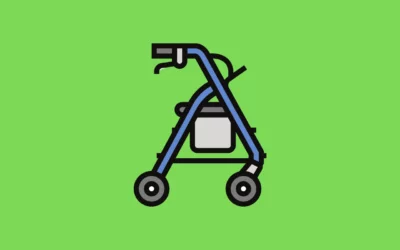Key Takeaways For Self-Propelled Wheelchair
Explore Wheelchair Options: Discover a range of self-propelled wheelchairs with varying features and prices for informed purchasing decisions.
Considerations for Self-Propelled Use: Assess whether a self-propelled wheelchair suits your needs, emphasizing independence, upper body strength, and individual capabilities.
Wheelchair Maneuverability Tips: Learn techniques to push a wheelchair without straining your back, emphasizing posture, elbow positioning, and the importance of using leg muscles.
Top Self-Propelled Wheelchairs
Learn about the wide types of self-propelled wheelchairs, how they work, and how to keep them in good working condition so you can make a well-informed buying decision.
What Does Self-Propelled Wheelchair Mean?
Wheelchairs with self-propulsion systems allow their users to move about without assistance from a caregiver.
Both self-propelled wheelchairs provide several personalisation possibilities to accommodate user requirements and preferences.
Is Self-Propelled Worth It?
Whether or not a person can benefit from a self-propelled wheelchair is context-dependent.
A self-propelled wheelchair is a good option if you value your independence and have the upper body strength and agility to push yourself.
However, persons unable to move freely due to conditions like spinal cord injuries or neurological issues may not be excellent candidates for self-propelled wheelchairs due to a lack of upper body strength or skill.
Before suggesting a self-propelled wheelchair or any other mobility equipment, a healthcare professional or physical therapist should thoroughly evaluate the individual’s needs and ability. They might be useful in determining which type of mobility best meets the customer’s needs.
How Do You Push A Wheelchair Without Straining Your Back?
Even though learning how to push a wheelchair correctly might protect your back from injury, it is still a strenuous physical activity.
The steps for pushing a wheelchair without hurting your back are described below.
- A broad, relaxed posture may help you stay stable and relieve back tension.
- Always keep your elbows bent at a 90-degree angle while dragging a wheelchair. Your neck, back, and shoulders will all thank you.
- If you want to push the wheelchair, you should use your leg muscles instead of your back muscles.
- Stopping often to stretch may help relax your back muscles.
- When lifting the wheelchair or moving the user into or out of the chair, take additional precautions to protect your back from injury.
- Wheelchair users should avoid juggling bags and other things while navigating their chairs.
- Consult a doctor or physical therapist if you’re having trouble utilising a wheelchair due to back pain.
If you keep these things in mind, you may be able to push a wheelchair with less effort.
What Are The Three Basic Types Of Wheelchairs?
Disabled people’s preferred modes of transportation include manual wheelchairs, electric wheelchairs, and mobility scooters.
- Individuals reliant on manual wheelchairs propel themselves or with the assistance of a caretaker by grasping the wheel’s hands and putting pressure on the wheel’s spokes. Because of their portability and ease of use, manual wheelchairs are perfect for indoor use.
- They can function well in enclosed and open environments and have high independence.
- These aids are often used by people with problems walking yet still need to get about.
How Do You Make A Wheelchair Easier To Propel?
Depending on the individual’s requirements, wheelchairs may be modified to make them more manageable while being pushed.
- Wheelchair propulsion should place less stress on the arms and wrists if the handrails are ergonomically sound.
- Different tyres provide varying degrees of resistance, so it’s up to the user to choose the right set. One example is pneumatic (air-filled) tyres, which provide a more comfortable ride but may need more work to push than their solid counterparts.
- If you’re having trouble pushing the wheelchair due to the seat’s height, try adjusting it higher or lower. Users should be able to reach the handrails from a sitting position with their elbows at a 90-degree angle.
- A lightweight manual wheelchair is a good option if the user can propel himself.
Using these suggestions, the wheelchair user may move more easily and comfortably. You should see a medical professional or physical therapist for advice on making your time in a wheelchair more enjoyable.
Are Self-Propelled Wheelchairs Easier To Push?
Whether or not a self-propelled wheelchair is easier to push depends on the needs and abilities of the user.
Some people may find it challenging to use a self-propelled wheelchair due to a lack of upper body strength or dexterity. This is especially true for those with limited mobility due to disorders like spinal cord injuries or neurological difficulties. A powered wheelchair or scooter may be the best option here.
Before suggesting a self-propelled wheelchair or any other mobility equipment, a healthcare professional or physical therapist should thoroughly evaluate the individual’s needs and ability. They might be useful in determining which type of mobility best meets the customer’s needs.
Is It Easier To Push A Wheelchair With Big Wheels Or Small Wheels?
There is some debate about whether larger or smaller wheels are preferable for a wheelchair in terms of manoeuvrability. You should determine wheel size after taking into account the following factors:
- Substrate: Vehicles with larger wheels are more comfortable travelling in and less prone to bogging down or trapped on rough or uneven ground. However, smaller wheels need less effort to spin, which may be simpler to push, particularly on a flat basis.
- Wheels with bigger diameters need less effort to spin, which may make them more accessible to those with weaker upper bodies. Users with a lot of upper body strength may find that the smaller wheels are preferred since they allow for more precision and manoeuvrability.
Can Someone Else Push A Self-Propelled Wheelchair?
Power wheelchairs eliminate the requirement for the user to make any muscular efforts to propel themselves around compared to manual wheelchairs. Users with self-propelled wheelchairs are the main operators. However, an assistant’s push is available. This may be necessary if the person in the wheelchair has problems, such as navigating tiny doors or uneven terrain. When pushing a self-propelled wheelchair, it’s crucial to take safety measures and adhere to the instructions provided by the manufacturer.
Top Self-Propelled Wheelchairs
Related Self-Propelled Wheelchair and Mobility Guides
- Best Self-Propelled Wheelchairs – Discover highly-rated self-propelled wheelchairs for enhanced independence.
- Wheelchair Buying Guide – Comprehensive tips for selecting the best wheelchair for your needs.
- Powerchair Buying Guide – Explore powerchairs as an alternative for mobility support.
- Best Cushions for Wheelchairs – Find cushions designed to improve wheelchair comfort and support.












